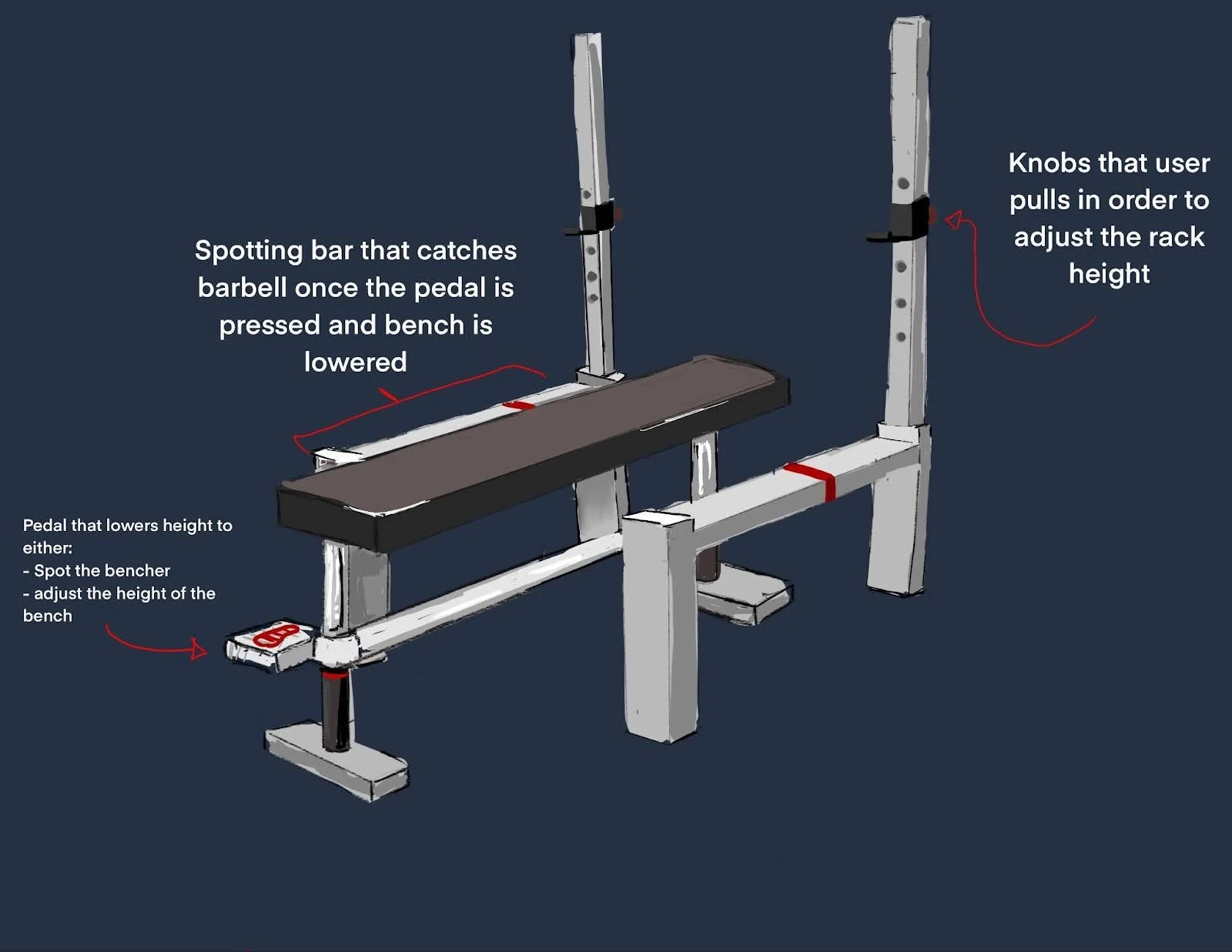Redesigning the Bench Press
Product analysis and Redesign.
Role
Spearheaded the redesign section and designed solutions in Figma.
Creating an animation to showcase product functionality
Conducted user interviews
Contributed to writing sections throughout case study
Team
Garrett Lee
Classmate 1
Classmate 2
Classmate 3
Classmate 4
Duration
1 Month
Overview
In this project, our team tackled a critical problem in gym equipment design — the lack of built-in safety mechanisms in the traditional bench press. Through extensive user research and iterative prototyping, we developed a redesigned bench press that integrates safety features and promotes user confidence, particularly when lifting without a spotter.
Problem
The traditional bench press poses significant risks, especially when users lift without a spotter. Many users reported fear of injury, hesitation to attempt personal records (PRs), and difficulty reracking weights. These safety concerns directly limit usability, causing users to self-impose physical limits due to a lack of affordances and constraints built into the bench press design.
“I’ve skipped PR attempts because I was too scared to bench without someone spotting.” — Interviewee
User Research
We conducted 18 semi-structured interviews with gym-goers of varying experience levels. Key findings:
83% (15 of 18) said they feared injury when bench pressing without a spotter.
33% (6 of 18) avoided attempting PRs due to safety concerns.
Users felt significantly safer when someone spotted them (average safety rating: 9.6/10) versus when lifting alone (average safety rating: 5/10).
Many users developed their own emergency escape strategies, such as sliding the bar down their body or tilting it to dump the weights — methods that carry additional risks.
This data revealed a clear opportunity: users were compensating for a lack of built-in safety through dangerous workarounds, indicating design failure and usability gaps.
Key Problems Identified
No self-spotting mechanism for failed lifts
Difficulty re-racking due to poor height alignment, especially for shorter users
Inability to adjust bench height, reducing effective force generation for shorter users
Mental and physical hesitation during benching due to safety concerns
Design Goals
Increase safety for solo bench press users
Promote confidence to lift without a spotter
Support proper form and performance regardless of user height
Maintain intuitive, discoverable interactions for all users
Design Process
We followed the Double Diamond Design Process:
Discover – Conducted interviews, observed user behavior, identified breakdowns in current bench press usage
Define – Framed the problem: “How might we design a bench press that empowers users to lift safely without a spotter?”
Develop – Brainstormed and prototyped multiple concepts including pedal mechanisms, adjustable racks, and self-spotting systems
Deliver – Finalized a redesign that blends intuitive safety features with performance usability
Design Concepts & Features
1. Lowering Pedal System
An emergency foot pedal allows the user to lower the bench height, letting the bar rest safely on self-spotting bars. This clear signifier acts as an “Oh Shit” button — a last-resort feature when a user cannot complete a lift.
Minimizes cognitive load during a failed lift
Accessible placement near the user's natural leg position
Supports multiple use cases: emergency exits and bench height adjustment
2. Self-Spotting Bars
Automated spotting bars activate when the pedal is pressed, catching the bar just above the user’s body. This provides:
A clear physical constraint for the barbell
Reduced risk of barbell collapse
Expanded use for other barbell-based exercises at waist height
3. Adjustable Rack Height
A rack-height adjustment mechanism accommodates users of all body sizes and arm lengths. Unlike traditional benches, users can set the perfect racking height, improving safety and control.
Peg-based design for intuitive adjustment
Visual signifiers guide discoverability
Reduces need for external assistance during setup and racking
Prototypes
We iterated on two versions:
Initial Prototype
Added multi-level racking
Introduced spotting bars based on user feedback
Identified the need for adjustable bench height
Final Prototype
Combined pedal + spotting bar system for full fail-safe usability
Adjustable racking and bench height built into one streamlined design
Created a compact, multi-functional machine that enhances safety and opens new lifting possibilities
Impact
By addressing the physical and psychological limitations of traditional benches, our redesign:
Empowers users to train independently
Reduces injury risk during failed lifts
Expands accessibility for users of all body types
Encourages more consistent progress in strength training
Conclusion
This case study demonstrates how thoughtful, user-centered design can radically improve both safety and confidence in strength training. By listening closely to user pain points and aligning our solution with core UX principles, we created a product that could help more people lift — and lift safely.





